|
Morality consists of suspecting other
people of not being married.
|
|
George Bernard Shaw, The Doctor's
Dilemma
|
Before Christianity started to take an interest in controlling
marriage, there had been little or no taint associated with
illegitimacy. Even in the Middle Ages families would be proud
to admit to having been founded by bastards. Many still bear
surnames starting with the element Fitz-, which often
indicates that the first bearer of the name was a royal bastard.
As Church influence over marriage grew stronger, sex was increasingly
discouraged outside marriage. Penances were imposed that depended
on factors such as age, marital status, and whether or not the
man was in Holy Orders1.
Class came into it as well. A man who seduced a serving girl
could expect half the penance of one who seduced a girl who
was his social equal. As Christianity grew stronger, so did
the stigma of illegitimacy. For example, fornication was not
a crime in the American colonies until Puritans made it one
in 1692. In some states it remained an offence until the late
twentieth century. In Arizona, for example, fornication was
punishable by three years imprisonment.
  By
Victorian times it was common for women's lives to be ruined
by a single indiscretion in their youth. The child would be
sent to an orphanage and the mother to a mental asylum. This
practice continued well into the twentieth century. In the 1990s,
there were still old women in mental asylums who had been there
for decades, and who were first committed for no other reason
that they had given birth to a child out of wedlock. Others
escaped their fate by murdering their new-born children and
hiding the bodies. Every so often such grisly relics are found,
often in old shoeboxes in attics. Children who were sent to
orphanages were generally informed that their parents were dead.
Thousands of such "orphans" were shipped from Britain
to Roman Catholic orphanages in Australia after World War II,
without the knowledge of their parents. Some discovered in adult
life that the Church had lied to them and they were not orphans
at all. Forty such women, brought up by the Sisters of Nazareth
in Garaldton, returned to Britain on the fiftieth anniversary
of their exile to be reunited with their families in 19972. By
Victorian times it was common for women's lives to be ruined
by a single indiscretion in their youth. The child would be
sent to an orphanage and the mother to a mental asylum. This
practice continued well into the twentieth century. In the 1990s,
there were still old women in mental asylums who had been there
for decades, and who were first committed for no other reason
that they had given birth to a child out of wedlock. Others
escaped their fate by murdering their new-born children and
hiding the bodies. Every so often such grisly relics are found,
often in old shoeboxes in attics. Children who were sent to
orphanages were generally informed that their parents were dead.
Thousands of such "orphans" were shipped from Britain
to Roman Catholic orphanages in Australia after World War II,
without the knowledge of their parents. Some discovered in adult
life that the Church had lied to them and they were not orphans
at all. Forty such women, brought up by the Sisters of Nazareth
in Garaldton, returned to Britain on the fiftieth anniversary
of their exile to be reunited with their families in 19972.
The term living in sin has a mildly humorous ring
to it now, but not so long ago it was widely used in all seriousness.
In 1995 there was considerable opposition when a Church of England
report suggested abandoning the term. In the past all Christians
genuinely believed, as a minority still do, that unmarried couples
are committing a grave sin. If one of the partners is married
to someone else, then they are committing adultery, an even
more serious matter under Church Law. After all, the Old Testament
clearly prescribed the death penalty (Deuteronomy 22:22 and
Leviticus 20:10). As recently as 1959, Geoffrey Fisher, the
then Archbishop of Canterbury, stated that adultery ought to
be a criminal offence.
One of the worst sexual sins in the eyes of churchmen was masturbation.
Masturbation was particularly loathed, yet priests felt compelled
to inquire into the minutest details during confession. A leading
fifteenth century theologian, Jean Gerson, Chancellor of the
University of Paris, wrote an entire treatise on hearing the
confessions of masturbators. Countless generations have been
terrified by stories of what God would do to those who practised
masturbation. They would go blind or deaf, or become insane,
or develop syphilis or gonorrhoea. The usual term for masturbation
was "self pollution" or "self abuse". As
for many other harmless practices, biblical authority was found
to condemn it, and as so often the interpretation was questionable.
According to the book of Genesis, God was displeased with Judah's
eldest son, so he killed him. Since he had died without issue,
Judah was concerned about his succession. The Leverite law stated
that in such circumstances a brother of the dead man should
marry the widow and raise any children in the dead man's name.
This duty fell to Onan:
And Judah said unto Onan, Go in unto thy brother's wife,
and marry her, and raise up seed to thy brother. And Onan
knew that the seed should not be his; and it came to pass,
when he went into his brother's wife, that he spilled it on
the ground, lest that he should give seed to his brother.
And the thing which he did displeased the Lord: wherefore
he slew him also.
Genesis 38:8-10
The reference to spilling seed probably denotes coitus
interruptus, rather than masturbation. Roman Catholic theologians
have traditionally favoured this interpretation because it provides
grounds to prohibit coitus interruptus as a form of
contraception3. In fact
Onan's offence is clearly not so much what he did, but what
he did not do. His error lay in disobeying his father, and not
doing what he had been instructed to do. This latter interpretation,
that Onan's offence was the wilful disobedience of the Leverite
law, is the one accepted by most rabbinical scholars4.
No matter, there was no other text to justify criticism of masturbation,
and Christian moralists needed one, so this one had to be pressed
into service.
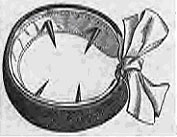  Well
into the twentieth century the state of New York officially
held that masturbation causes insanity. God, too, apparently
shared such misapprehensions for he revealed all manner of erroneous
information to Protestants, Roman Catholics and other Christians.
To Ellen White, the founder of the Seventh Day Adventists, he
disclosed that masturbation would
render a man a cripple and an imbecile. Such stories were supported
not only by churchmen but also by Christian physicians who gave
the stamp of medical approval. Doctors assured their patients
that masturbation caused all manner of ills, from back pain
to epilepsy. Up until the middle of the twentieth century almost
every adult in a Christian community was, as Bertrand Russell
said, more or less diseased nervously as a result of the taboo
on sex knowledge when he or she was young. Even today it is
not difficult to find fervent Christians who will affirm in
all seriousness that masturbation causes impotence, blindness,
deafness, insanity, and venereal disease, and that it will result
in hair growing on the palms of the hands. Although all of these
supposed symptoms are imaginary, Christian children of many
denominations are still threatened with them. Well
into the twentieth century the state of New York officially
held that masturbation causes insanity. God, too, apparently
shared such misapprehensions for he revealed all manner of erroneous
information to Protestants, Roman Catholics and other Christians.
To Ellen White, the founder of the Seventh Day Adventists, he
disclosed that masturbation would
render a man a cripple and an imbecile. Such stories were supported
not only by churchmen but also by Christian physicians who gave
the stamp of medical approval. Doctors assured their patients
that masturbation caused all manner of ills, from back pain
to epilepsy. Up until the middle of the twentieth century almost
every adult in a Christian community was, as Bertrand Russell
said, more or less diseased nervously as a result of the taboo
on sex knowledge when he or she was young. Even today it is
not difficult to find fervent Christians who will affirm in
all seriousness that masturbation causes impotence, blindness,
deafness, insanity, and venereal disease, and that it will result
in hair growing on the palms of the hands. Although all of these
supposed symptoms are imaginary, Christian children of many
denominations are still threatened with them.
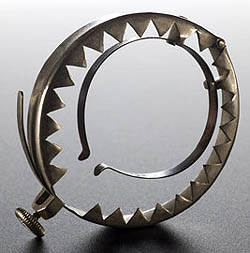  William
of Auvergne pointed out in the thirteenth century that male
masturbators are automatically guilty of a number of crimes
including homicide and sodomy (homicide because the semen was
spilled unproductively, sodomy because it was not being deposited
in a proper vessel). Apart from the shame, guilt, and embarrassment
associated with masturbation, penalties for it could be severe.
At one time seminal emission attracted a penalty of seven days
fasting if it was involuntary and 20 days if it was physically
assisted. Monks masturbating in church were liable to a fast
of 30 days, and bishops to 505.
No punishment succeeded in eliminating this vice, and masturbation
was still a major problem in Victorian times. Boys might be
infibulated, i.e. have wires threaded through their foreskins
to prevent them from masturbating. Alternatively, spiked metal
rings could be fitted around the penis to discourage tumescence. William
of Auvergne pointed out in the thirteenth century that male
masturbators are automatically guilty of a number of crimes
including homicide and sodomy (homicide because the semen was
spilled unproductively, sodomy because it was not being deposited
in a proper vessel). Apart from the shame, guilt, and embarrassment
associated with masturbation, penalties for it could be severe.
At one time seminal emission attracted a penalty of seven days
fasting if it was involuntary and 20 days if it was physically
assisted. Monks masturbating in church were liable to a fast
of 30 days, and bishops to 505.
No punishment succeeded in eliminating this vice, and masturbation
was still a major problem in Victorian times. Boys might be
infibulated, i.e. have wires threaded through their foreskins
to prevent them from masturbating. Alternatively, spiked metal
rings could be fitted around the penis to discourage tumescence.
A chastity belt is a locking item of clothing designed to prevent
sexual intercourse. Such belts were historically designed for
women, for the purpose of ensuring chastity, in order to protect
them from rape or to prevent women and their potential sexual
partners from engaging in coitus. Some devices were especially
designed to prevent masturbation. Uninterrupted long-term wear
could have caused genitourinary infection, abrasive wounds,
sepsis and eventual death.
  Christian
apologists have recently taken to denying that chastity belts
were ever used, or alternatively that they were a Victorian
invention. In fact Gregory the Great, Alcuin of York, Bernard
of Clairvaux and Nicholas Gorranus all made reference to 'chastity
belts' within their discourses, and museums around Europe possess
dozens of pre-victorian examples. Christian
apologists have recently taken to denying that chastity belts
were ever used, or alternatively that they were a Victorian
invention. In fact Gregory the Great, Alcuin of York, Bernard
of Clairvaux and Nicholas Gorranus all made reference to 'chastity
belts' within their discourses, and museums around Europe possess
dozens of pre-victorian examples.
The first detailed actual mention of what could be interpreted
as "chastity belts" in the West is in Konrad Kyeser
von Eichstätt's Bellifortis (1405), which describes
the military technology of the era. The book includes a drawing
that is accompanied by the Latin text: "Est florentinarum
hoc bracile dominarum ferreum et durum ab antea sic reseratum."
("These are hard iron breeches of Florentine women which
are closed at the front.")
|
Nether part of a Venetian chastity belt
on display in the Doge's palace. (Labelled 16th–17th
century.)
|
|
|
From the eighteenth century and well into the twentieth centuries,
masturbation regarded by Western Christian physicians as harmful.
Numerous mentions are found in medical journals of the time
of the use of chastity belt-like devices to prevent female masturbation
in women and girls. Many designs for anti-masturbation devices
were filed in Patent Offices up until the early 1930s.
  For
girls, matters could be worse. Father J. C. Debreyne, a Trappist
monk and physician, who had his own list of imaginary symptoms
caused by masturbation, favoured the surgical removal of the
clitoris from female offenders. It was after all only an organ
of pleasure, superfluous to the act of procreation. Clitorectomies
(sometimes called female circumcisions) were performed on Christian
girls, just as they still are on Muslim girls. In the late nineteenth
century Dr Jules Guerin of London claimed to effect excellent
cures on masturbators by cauterising the clitoris6.
All this because Christian theologians believed masturbation
to be worse than incest or murder. Infibulations and clitorectomies
are no longer tolerated, but the Church still clings to its
ancient attitudes. As a modern theologian has observed: For
girls, matters could be worse. Father J. C. Debreyne, a Trappist
monk and physician, who had his own list of imaginary symptoms
caused by masturbation, favoured the surgical removal of the
clitoris from female offenders. It was after all only an organ
of pleasure, superfluous to the act of procreation. Clitorectomies
(sometimes called female circumcisions) were performed on Christian
girls, just as they still are on Muslim girls. In the late nineteenth
century Dr Jules Guerin of London claimed to effect excellent
cures on masturbators by cauterising the clitoris6.
All this because Christian theologians believed masturbation
to be worse than incest or murder. Infibulations and clitorectomies
are no longer tolerated, but the Church still clings to its
ancient attitudes. As a modern theologian has observed:
...anyone who derives his theology from Catholic moral theologians
will be convinced, even today, that masturbation wastes the
spinal marrow, softens or desiccates the brain, and can generally
impair the constitution7.
  Because
of their association with sex, the genitals were generally seen
as vile and disgusting. So it is that we refer to them by the
Latin name pudenda, from pudendus meaning
"of which one ought to be ashamed". In England our
straightforward native Saxon terms have been forced out of use
or reduced to the status of obscenities. Missionaries down the
centuries, even to the present day, have encouraged potential
converts to think of their genitals as shameful and dirty. Shame
is introduced to make all cultures more like the guilt-ridden
ones of Christendom. Even so, it seems that clothing does not
always guarantee freedom from temptation to natural desire,
at least if we are to make inferences from the incidence of
red-haired aborigine babies in the wake of Irish missions in
Australia. Because
of their association with sex, the genitals were generally seen
as vile and disgusting. So it is that we refer to them by the
Latin name pudenda, from pudendus meaning
"of which one ought to be ashamed". In England our
straightforward native Saxon terms have been forced out of use
or reduced to the status of obscenities. Missionaries down the
centuries, even to the present day, have encouraged potential
converts to think of their genitals as shameful and dirty. Shame
is introduced to make all cultures more like the guilt-ridden
ones of Christendom. Even so, it seems that clothing does not
always guarantee freedom from temptation to natural desire,
at least if we are to make inferences from the incidence of
red-haired aborigine babies in the wake of Irish missions in
Australia.
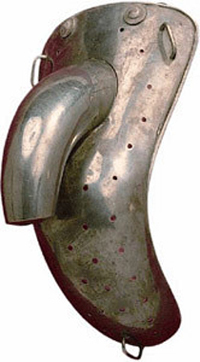  Christian
doctors lent credibility to a host of fictions in their polemic
against masturbation, largely designed to terrify children,
adolescents and adults for normal healthy activities. While
Christian Church leaders promised torture in the next life,
Christian doctors promised torture in this life. One such, in
Britain was William Acton. In the USA, John Harvey Kellogg,
co-inventor of the famous breakfast cereal, and a Seventh Day
Adventist Christian, was one of many Christian doctors obsessed
by the imaginary evils of masturbation. As an advocate of sexual
abstinence, Kellogg devoted large amounts of his educational
and medical work to discouraging sexual activity on the basis
of dangers both real (eg sexually transmissible diseases) and
imaginary. Christian
doctors lent credibility to a host of fictions in their polemic
against masturbation, largely designed to terrify children,
adolescents and adults for normal healthy activities. While
Christian Church leaders promised torture in the next life,
Christian doctors promised torture in this life. One such, in
Britain was William Acton. In the USA, John Harvey Kellogg,
co-inventor of the famous breakfast cereal, and a Seventh Day
Adventist Christian, was one of many Christian doctors obsessed
by the imaginary evils of masturbation. As an advocate of sexual
abstinence, Kellogg devoted large amounts of his educational
and medical work to discouraging sexual activity on the basis
of dangers both real (eg sexually transmissible diseases) and
imaginary.
He set out his views on such matters in one
of his books, published in various editions around the start
of the 20th century under the title Plain Facts about Sexual
Life and later Plain Facts for Old and Young. Like
many other Christians was a zealous campaigner against masturbation.
Kellogg claimed that "neither the plague, nor war, nor
small-pox, nor similar diseases, have produced results so disastrous
to humanity as the pernicious habit of onanism," citing
a supposed medical authority. Kellogg strongly warned about
masturbation-related deaths noting that "such a victim
literally dies by his own hand". He felt that masturbation
destroyed not only physical and mental health, but also the
moral health of individuals.
|
Onania, or the Heinous Sin of Self Pollution,
and its Frightful Consequences In Both SEXES Considered...,
1723
|
|
|
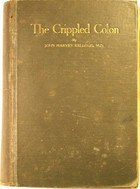  Some
of his milder ideas involved diet. Those experiencing sexual
temptation were to avoid stimulating food and drinks, and eat
very little meat, or none at all. Kellogg's Corn Flakes were
developed as a suitable breakfast food for Christians keen to
give up habitual masturbation. Some
of his milder ideas involved diet. Those experiencing sexual
temptation were to avoid stimulating food and drinks, and eat
very little meat, or none at all. Kellogg's Corn Flakes were
developed as a suitable breakfast food for Christians keen to
give up habitual masturbation.
Kellogg also stressed the importance of keeping
the colon clean using yoghurt enemas. Although a qualified medical
doctor, he taught that the practice of masturbation, the"solitary-vice",
caused cancer of the womb, urinary diseases, nocturnal emissions,
impotence, epilepsy, insanity, and mental and physical debility;
as well as "dimness of vision".
|
Consequences of practising the "Solitary
Vice"
|
|
|
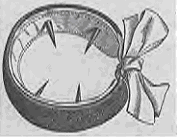  He
also encouraged enclosing the penis in a metal band with sharpened
spikes pointing in to render excruciatingly painful even involuntary
night erections. He must have found a large market, since involuntary
night erections occur in almost all healthy sleeping boys. He
also encouraged enclosing the penis in a metal band with sharpened
spikes pointing in to render excruciatingly painful even involuntary
night erections. He must have found a large market, since involuntary
night erections occur in almost all healthy sleeping boys.
He worked on the rehabilitation of masturbators of both sexes,
employing genital mutilation, preferably without anaesthetic
since the pain would emphasise a moral lesson. In his Plain
Facts for Old and Young, he wrote:
"A remedy which is almost always successful in small
boys is circumcision, especially when there is any degree
of phimosis. The operation should be performed by a surgeon
without administering an anaesthetic, as the brief pain attending
the operation will have a salutary effect upon the mind, especially
if it be connected with the idea of punishment, as it may
well be in some cases. The soreness which continues for several
weeks interrupts the practice, and if it had not previously
become too firmly fixed, it may be forgotten and not resumed.
"
and on a method of treatment to prevent masturbation
" ... we have employed it with entire satisfaction.
It consists in the application of one or more silver sutures
in such a way as to prevent erection. The prepuce, or foreskin,
is drawn forward over the glans, and the needle to which the
wire is attached is passed through from one side to the other.
After drawing the wire through, the ends are twisted together,
and cut off close. It is now impossible for an erection to
occur, and the slight irritation thus produced acts as a most
powerful means of overcoming the disposition to resort to
the practice "
Girls fared no better:
" In females, the author has found the application of
pure carbolic acid (phenol) to the clitoris an excellent means
of allaying the abnormal excitement. "
He also recommended, to prevent children from this "solitary
vice", bandaging or tying their hands, covering their genitals
with patented cages and electrical shock. In his Ladies'
Guide in Health and Disease, for nymphomania, he recommended
" Cool sitz baths; the cool enema; a spare diet; the
application of blisters and other irritants to the sensitive
parts of the sexual organs, the removal of the clitoris and
nymphae..."
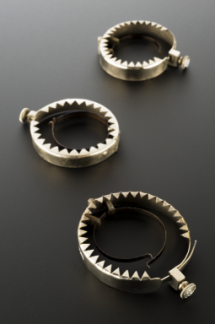  Masturbation
was not the only dangerous and sinful sex crime. He warned that
many types of sexual activity, including many "excesses"
that couples could be guilty of within marriage, were against
nature, and therefore, unhealthy. Masturbation
was not the only dangerous and sinful sex crime. He warned that
many types of sexual activity, including many "excesses"
that couples could be guilty of within marriage, were against
nature, and therefore, unhealthy.
He drew on the warnings of William Acton and expressed support
for the work of Anthony Comstock.
For many non-Christians it is difficult to credit the extent
to which Christian societies have gone to suppress sexual matters.
Not so long ago nuns and convent girls were expected to take
their baths in swimming costumes, or with the bath sheeted over.
The reason was that otherwise their naked bodies might be seen
by God, or by their guardian angel, or by one of the host of
other spiritual beings who frequent our bathrooms. Many children
in Christian countries still reach puberty without having learned
anything of basic human sexual physiology. Adolescent boys raised
by Christians are often surprised to find themselves experiencing
spontaneous nocturnal seminal emissions, and girls are often
horrified at their first menstruation. In many non-Christian
cultures such events are much less traumatic: children are familiar
with sex and sexuality from an early age because such matters
are ordinary, natural aspects of everyday life.
|
Excerpt from US by Jonas E. Heyser, Patented
J 11119 20, 1911
(Application filed January 19, 1910, Serial No. 538,829.
Renewed November 9, 1910. Serial No. 591,533.)
"My invention relates-to improvements in surgical
appliances and more particularly to devices for preventing
masturbation by males, the object of the invention being
to provide an improved device of this character which
may be secured on the body of the patient and which cannot
be removed by the patient, and which will absolutely prevent
any attempt on the part of the patient to masturbate."
|
|
|
  Since
the twentieth century, it has become apparent that Christian
communities have found a variety of ways to induce sexual ecstasy,
often presented as religious ecstasy. Examples are flagellation,
constraint and other Sadomasochistic
practices often described as "discipline". Some
sects use self denial and rhythmic chanting to achieve altered
states of consciousness. Another, perhaps unlikely, method employs
snake handling to induce ecstasy. Since Freud wrote about sublimated
sex, an ever wider range of people have become aware of the
difficulties in distinguishing religious from sexual ecstasies. Since
the twentieth century, it has become apparent that Christian
communities have found a variety of ways to induce sexual ecstasy,
often presented as religious ecstasy. Examples are flagellation,
constraint and other Sadomasochistic
practices often described as "discipline". Some
sects use self denial and rhythmic chanting to achieve altered
states of consciousness. Another, perhaps unlikely, method employs
snake handling to induce ecstasy. Since Freud wrote about sublimated
sex, an ever wider range of people have become aware of the
difficulties in distinguishing religious from sexual ecstasies.
Christian societies are now slightly more realistic than they
once were. The second Council of Mâcon in 585 decreed
that male corpses should not be buried next to female ones until
they had decomposed8. One
could never be too careful in matters sexual. The obsession
with sex often had dire results. Not so long ago gynaecologists
could carry out physical examinations only when absolutely necessary.
And even then it was common practice for such examinations to
be carried out under sheets in darkened rooms. In the early
nineteenth century a Philadelphia professor could boast of American
women that they "prefer to suffer the extremity of danger
and pain rather than waive those scruples of delicacy which
prevent their maladies from being fully explored"9.
We shall never know how many thousands of women have died unnecessarily,
protecting their Christian modesties from the attentions of
the medical profession.
  Most
of the extreme Christian ideas are now discarded and forgotten,
having been superseded by liberal, secular and scientific ones.
Sometimes all that was necessary was for a nonbeliever to bring
the Christian-inspired practice to public notice, and public
opinion did the rest. Most
of the extreme Christian ideas are now discarded and forgotten,
having been superseded by liberal, secular and scientific ones.
Sometimes all that was necessary was for a nonbeliever to bring
the Christian-inspired practice to public notice, and public
opinion did the rest.
As we have already noted, at the end of the nineteenth century
female masturbation was sometimes prevented by excising the
clitoris, or cauterising it with red-hot irons, this operation
being advocated and practised by Christian physicians. Such
practices fell out of use after being publicised by an atheist
physician named Sigmund Freud10.
|
Some Christians still hold to the traditional
line that masturbation is a sin
|
|
|
|